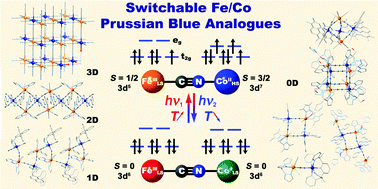Switchable Fe/Co Prussian blue networks and molecular analogues
Abstract
With the long term objective to build the next generation of devices from the molecular scale, scientists have explored extensively in the past two decades the Prussian blue derivatives and their remarkable physico-chemical properties. In particular, the exquisite Fe/Co system displays tuneable optical and magnetic behaviours associated with thermally and photo-induced metal-to-metal electron transfer processes. Recently, numerous research groups have been involved in the transfer of these electronic properties to new Fe/Co coordination networks of lower dimensionality as well as soluble molecular analogues in order to facilitate their manipulation and integration into devices. In this review, the most representative examples of tridimensional Fe/Co Prussian blue compounds are described, focusing on the techniques used to understand their photomagnetic properties. Subsequently, the different strategies employed toward the design of new low dimensional Prussian blue analogues based on a rational molecular building block approach are discussed emphasizing the advantages of these functional molecular systems.


 Please wait while we load your content...
Please wait while we load your content...